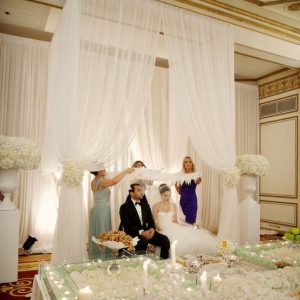Persian Wedding Dance and Other Persian Wedding Traditions
Here at Bella Ballroom, we teach dance to wedding couples from a variety of different cultures and backgrounds. In Orange County, CA there is a prominent Persian community, so we have the opportunity to work with Persian couples often. Persian brides and grooms will commonly pick a romantic Persian song for their first dance, although  not always. In addition to their first dance, many couples ask us to help them plan their wedding entrance. I’ve found that Persian wedding entrances often involve the bride and groom circling around the room to Persian music as they are surrounded and cheered on by their friends and family. As an International Dance artist, I’ve had the pleasure of performing Persian dance during both the wedding entrance and reception ceremony. It’s always been a lively and beautiful experience. It’s safe to say that dance is an important part of Persian wedding celebrations.
not always. In addition to their first dance, many couples ask us to help them plan their wedding entrance. I’ve found that Persian wedding entrances often involve the bride and groom circling around the room to Persian music as they are surrounded and cheered on by their friends and family. As an International Dance artist, I’ve had the pleasure of performing Persian dance during both the wedding entrance and reception ceremony. It’s always been a lively and beautiful experience. It’s safe to say that dance is an important part of Persian wedding celebrations.
Recently, I learned about a Persian wedding dance custom that I had never heard of. The cake knife dance, known as Raghseh Chagoo, is a Persian wedding tradition that begins the cake cutting. When the bride and groom are ready to cut the cake, they have to earn the knife. A female family member or friend will begin to dance with the knife (most typically to Persian music.) The couple must offer money to the dancing friend in exchange for the knife. The dancer may act coy and take the money, only to give the knife to another woman to continue the knife dance. This will continue until one of the dancers decide that they have been won over by the given money and will give the bride and groom their cake knife in exchange.
The Persian knife dance is not the only tradition unique to Persian weddings. In fact, Persian wedding ceremonies that come from ancient Zoroastrian ritual rituals can very differently even within Iran depending on the region. Persian weddings traditionally are done in two stages: the legal contractual ceremony known as “Aghd” and the reception ceremony, known as “Jashn-e Aroosi.”
The Aghd ceremony takes place in a room with a wedding spread known as “Safreh-ye Aghd.” This spread is a set on a special fabric that is set on the floor so that it faces East towards sunlight. The bride and groom will set at the head of the spread that will include a variety of items with important symbolism. Gold coins symbolize wealth and success. Eggs or nuts are used to represent fertility. Honey or sugar represent sweetness. Two candleabras and a mirror represent light for the couple’s future. Incense is used to ward off the evil eye. During the Aghd ceremony, married female family members hold a fabric shawl or scarf over the heads of the bride and groom. The groom is asked if he will marry the bridge only once. The bride is asked the same question three times before she will give an answer. This is to symbolize the grooms pursuit of the bride.
The party reception known as the Aroosi follows the Aghd and can last from three to seven days. The parties include family and friends. They are much like any Western wedding reception in that feasting, celebration, cake, music, and dancing are a must. While traditionally the groom’s family will pay for these wedding parties, modern couples often share the cost. The Aroosi can take place in a home, park, restaurant or reception hall. The meal is traditionally buffet style and may include a variety of dishes including Jahaver Polo, a dish with rice, orange peel, berries, almonds, and pistachios. The dish is colorful and signifies jewels. The name of the dish can be translated to “jeweled rice.”
If you’re not Persian and don’t know what to expect when going to a Persian wedding in the United States, you’re in for a treat. Typically Persian weddings in Orange County include old customs and traditions mixed with a modern touch. The guest’s attire is usually very formal with the men wearing suits and ties and the women wearing fancy gowns and jewelry with their hair and make-up fully done. Persian weddings usually have a large number of guests that include the bride and groom’s family, extended family, friends, and acquaintances. While the wedding reception (Aroosi) can have several invitees, the Aghd is more intimate and is reserved for closer family to attend as the couple exchange their “I do”s and wedding rings.
The Aroosi in the United States are very similar to its Western wedding receptions in that the bride and groom usually share a first dance, the families will do a toast, and the bride and groom will partake in the garter and bouquet toss. Lots and lots of dancing is expected. After the cake is served, guests join in a Persian tradition of showering the newlyweds with rose petals as they dance.
From Orange County to Iran, Persian wedding ceremonies are to be enjoyed and celebrated. Persian wedding traditions are rich, beautiful, and meant to wish the newlyweds well into a bright future together.
Article by Ziva

